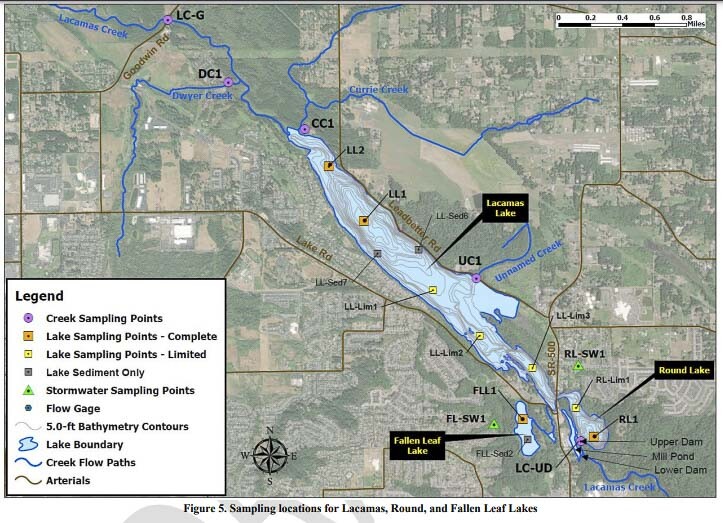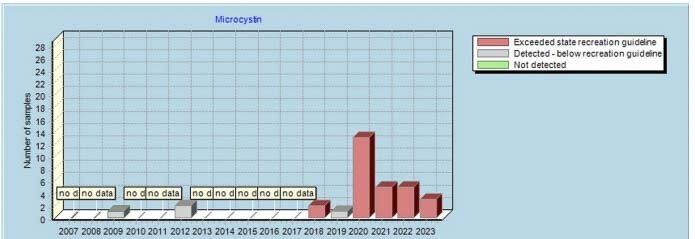Three-phase plan, with a price tag of $4.1 million, would last a decade
John Ley
for Clark County Today
After four years of talk and public outreach, and often near-constant ”caution” or “warning” signs out around Lacamas Lake, the city of Camas revealed its Water Management Plan to the community Thursday (Sept. 28) evening. The Camas City Council held a special meeting to review the 331 pages of the consultant’s study and staff recommended plan.
During the past week, the Clark County Council also held discussions about the lake water problems. Because there are approximately 67 square miles within the Lacamas Creek watershed, much of the water flowing into the three lakes (Lacamas, Round, and Hidden Leaf) comes from land not inside the Camas city limits. County Councilor Gary Medvigy has been fighting to get an Interlocal Agreement between the city and county for over two years in the hopes a joint effort could better secure state help and funds.
The city had allocated $300,000 initially to conduct the current study. Evaluations of the lake water have taken place multiple times since the 1980s. The final report came at a cost of over $500,000 and 13 months of studying the water quality. The recommended 10-year plan will have three phases and a potential cost of $4.1 million. Public Works Director Steve Wall said the staff has allocated $250,000 in next year’s budget for lake water management; roughly half of the expected annual cost.

One critical piece of the community discussion has been the failed biofilter of the Lacamas Shores Homeowners Association (LS HOA). Local citizens led by Marie Tabata Callerame of the Lacamas Watershed Council, did their own testing of the biofilter three years ago . They found the biofilter was actually adding significant amounts of pollutants to the lake water, rather than cleaning stormwater. Callerame has been looking into lake water issues since 2014.
Lacamas Creek accounts for 90 percent of the water inflow, but just 72 percent of the total phosphorus measured during the year-long study. The city’s consultant tested water or sediment at approximately 18 separate locations around the lake, including four creeks. They report a 60 percent reduction of phosphorus from the Lacamas Creek watershed would be needed to keep the lake water healthy.
The lake water is “eutrophic,” a condition high in nutrients that prevents the light penetration and oxygen absorption necessary for underwater life. Eutrophic waters are often murky and may support fewer large animals, such as fish and birds, than non-eutrophic waters. The past four years the state Department of Ecology reports Lacamas Lake water has exceeded allowable standards.
Conspicuously absent was any testing near the LS HOA or the Camas Meadows Golf Course. The golf course uses significant fertilizer, but expends a great deal of time and effort to ensure all the water used is properly treated and remains on course-owned lands. The LS HOA has not done so, which triggered a lawsuit by homeowner Steve Bang. Earlier this summer, the Clark County Superior Court ruled the LS HOA had failed to maintain its biofiler in accordance with their covenants, conditions, and restrictions (CC&R).
Wall and Jacob Krall of Geosyntec reported the primary problem is phosphorus in the water. It “feeds” the growth of the toxic algae cyanobacteria. A 1985 study found the sediment in the bottom of Lacamas and Round lakes was not significant. That is no longer the case today.
There is roughly 157,000 acre feet of water flowing into the lake a year, approximately 21 times lake capacity. Clark County recently concluded its own study of the watershed. It found the highest levels of phosphorus came from China Ditch and Lower 5th Plain Creek.
But during public comment, Callerame emphasized that the phosphorus coming from the LS HOA’s failed biofilter was 3 to 10 times the highest levels detected from Currie Creek. Instead of retaining and treating the water within the biofilter, the stormwater runs through most parts of the biofilter and directly into the lake untreated.
The report indicates incoming water remains in the two lakes an average of 17 days before exiting through the city-owned dams. Depending on rain and water flow, the entire volume of water would mathematically be replaced 23 times a year. The water remains in the lake anywhere from 11 to 83 days according to the report.
Every fall, the city lowers the water in the Lacamas and Round lakes for about six weeks to inspect and effect repairs on two city owned dams. This process is currently underway.
Three concerned citizens collect water samples from multiple locations around the Lacamas Shores HOA biofilter in September 2020. After at most 30 minutes of rain, the stormwater collection system was overflowing and failing to treat the polluted water. Instead the water was flowing untreated directly into Lacamas Lake. Video courtesy John Ley
It was noted that there are “point sources” and “nonpoint sources’’ of phosphorus needed to be dealt with. The bottom of Lacamas and Round lakes have about 20 percent of pollutants on the bottom in the sediment. The staff proposal is to treat the phosphorus on the bottom in a separate phase from the phosphorus entering the lakes via the creeks. They note generally the bottom doesn’t get stirred up, especially in the deeper parts of the lakes.
Chemical treatment via alum or a brand name product like Phoslock or Eutrosorb G was recommended. A different form of treatment that adds oxygen to the water could be used in addition to chemicals. A somewhat new version of adding oxygen to water is using nanobubbles. Councilor Medvigy shared this with the community several years ago, as part of a multi-phase approach to getting the lake water safe for public use.
Three-phase plan
The proposed plan has three phases. First is an annual removal of phosphorus from the water column using chemical treatment – beginning Spring 2024. Next is the inactivation of phosphorus in the sediments using chemical treatment over 5-10 years – beginning Spring 2024. Finally, an ongoing reduction of phosphorus loading from the watershed, through continued partnerships with Clark County and other regional and state organizations.
Cleaning the incoming water to Lacamas Lake is recommended using alum or Eutrosorb WC once a year. The projected cost ranges from $70,000 – $190,000. If they cleaned both Lacamas and Round lakes, the cost would be $90,000 – $225,000. They say the treatment will not negatively impact marine life or the ability of people to swim in the water.
The second phase would target areas where water depths exceed 30 feet for treatment of 88 acres in Lacamas Lake and 11 acres in Round Lake. The annual cost could be $260,000 – $340,000 for Lacamas Lake and $260,000 – $390,000 for Lacamas and Round Lakes.
One option supposedly “not recommended” was treating the water where Lacamas Creek flows into Lacamas Lake. Staff said it would involve additional construction. They estimated annual costs would be $260,000 – $340,000 for Lacamas Lake or $260,000 – $390,000 for Lacamas and Round Lakes.
The staff and consultant also didn’t recommend nanobubbles, hypolimnetic aeration or oxygenation, This was in spite of the costs being approximately the same as the chemical treatment. Callerame mentioned they could be rented, if the city didn’t want to permanently own them. It was pointed out that both systems are mobile and could be used in different locations.
A state Ecology Alternative Restoration Plan is expected to be completed in January 2025. The city has received a $515,000 grant from the 2023-25 state budget.

Also read:
- Clark County settles wrongful shooting lawsuit for $3.5 millionClark County will pay $3.5 million to the family of Jenoah Donald following a fatal officer-involved shooting during a 2021 traffic stop.
- No tax on tips, child tax credit and business tax cuts survive in big House GOP billThe U.S. House Ways and Means Committee passed a major GOP tax bill including cuts for businesses, temporary no-tax-on-tips benefits, and adjustments to the child tax credit.
- Letter: ‘IBR has relied on this video to instill fear in the public and government officials to promote the construction of a new bridge’Bob Ortblad questions IBR’s use of a seismic video and urges a shift toward tunnel alternatives in this critical letter to the editor.
- Vancouver City Council approves $11.15 million to help create or preserve 330 affordable rental homesVancouver City Council has approved $11.5 million in housing funds to support 330 affordable homes for seniors, families, and vulnerable residents.
- Troubled TriMet and fleecing taxpayers with LRTJohn Ley analyzes TriMet’s ridership decline and what it signals for post-pandemic public transit in the region.
- Washougal School District students work together to bring art to lifeMiddle school students in Washougal helped transform younger students’ monster art into real stuffed creations as part of a collaborative art project.
- Commission on Aging to focus on health and fitness at May meetingClark County’s Commission on Aging will host a May 21 meeting focused on health, fitness, and the needs of older adults.












Pretty interesting, I brought a similar issue up to the city of Camas and was completely ignored. the storm water form the norther part of Lacamas Summit subdivision discharges into a trench that runs down the green space behind my house, by-passing the storm water filter #88 and runs through my back yard and right into round lake. This is un-treated roof and street run off and is not an Insignificant amount of water. This water needs to be piped over to the completely empty and dry storm water facility #88 where it belongs. I can’t even believe the city/county let the contractor get away with this.
“The testing locations did not include the privately owned golf course or the Lacamas Shores neighborhood. ”
“One critical piece of the community discussion has been the failed biofilter of the Lacamas Shores Homeowners Association (LS HOA).”
“Earlier this summer, the Clark County Superior Court ruled the LS HOA had failed to maintain its biofiler in accordance with their covenants, conditions, and restrictions (CC&R). ”
This seems like negligence, failing to test in areas of known concern, and a golf course next to the Lake. For $500,000 spent by the City of Camas for the study to test various areas over 13 months, failing to test in these areas difficult to understand.